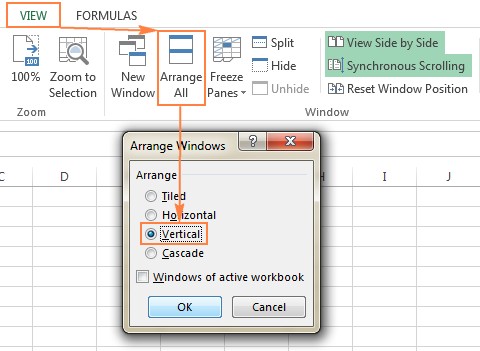Comparing and merging Excel spreadsheets can be a daunting task, but with the right methods, it can be streamlined. How To Compare And Merge Two Excel Spreadsheets? COMPARE.EDU.VN provides detailed guidance on various techniques, from side-by-side viewing to advanced third-party tools, ensuring you can effectively manage and consolidate your data. This guide will explore formulas, conditional formatting, and specialized software to simplify your workflow. This will help improve data accuracy and efficiency.
1. Viewing Excel Files Side by Side
This method is ideal for smaller spreadsheets where you can visually identify differences.
1.1. Comparing Two Excel Workbooks
To open two Excel files side by side:
-
Open both workbooks you wish to compare.
-
Navigate to the View tab, locate the Window group, and click View Side by Side.
By default, Excel displays the windows horizontally.
To arrange them vertically, click Arrange All and select Vertical.
To synchronize scrolling between both worksheets, enable the Synchronous Scrolling option in the Window group under the View tab.
1.2. Arranging Multiple Excel Windows Side by Side
For more than two files:
- Open all Excel workbooks you want to compare.
- Click View Side by Side.
- In the Compare Side by Side dialog box, select the files you want to display.
To view all open Excel files simultaneously, click Arrange All in the Window group under the View tab and choose your preferred arrangement (tiled, horizontal, vertical, or cascade).
1.3. Comparing Two Sheets in the Same Workbook
To compare two sheets within the same workbook:
- Open the Excel file.
- Go to the View tab, and in the Window group, click New Window.
- This opens the same file in a new window.
- Enable View Side by Side mode.
- Select the first sheet in one window and the second sheet in the other window.
2. Using Excel Formulas to Compare Data
Formulas can help identify cells with different values, creating a difference report.
2.1. Creating a Difference Report
-
Open a new, empty sheet.
-
Enter the following formula in cell A1:
=IF(Sheet1!A1 <> Sheet2!A1, "Sheet1:"&Sheet1!A1&" vs Sheet2:"&Sheet2!A1, "") -
Drag the fill handle (the small square at the bottom-right of the cell) down and to the right to apply the formula to other cells.
This formula compares corresponding cells in Sheet1 and Sheet2 and displays the differences in the new sheet. Note that dates are represented by their serial numbers, which may not be convenient.
3. Highlighting Differences Using Conditional Formatting
Conditional formatting can visually highlight different values in two sheets.
3.1. Applying Conditional Formatting
-
Select all used cells in the worksheet where you want to highlight differences.
- Click the top-left cell (usually A1) and press Ctrl + Shift + End.
-
On the Home tab, in the Styles group, click Conditional Formatting > New Rule.
-
Create a new rule using the formula:
=A1<>Sheet2!A1Replace
Sheet2with the name of the other sheet you are comparing.This highlights cells with different values in the selected color.
Formulas and conditional formatting are useful but have limitations:
- They only compare values, not formulas or formatting.
- They don’t detect added or deleted rows and columns.
- They operate at the sheet level and don’t detect workbook-level structural differences.
4. Compare and Merge Copies of a Shared Workbook
Excel’s Compare and Merge feature is useful for collaborative work on the same Excel file.
4.1. Preparing for Compare and Merge
- Share the Excel workbook before making it available to others.
- Click the Share Workbook button on the Review tab, in the Changes group.
- Select Allow Changes by More Than One User… and click OK.
- Save the workbook if prompted. Track Changes shares the workbook automatically.
- Each user must save a copy of the shared workbook with a unique filename.
4.2. Enabling the Compare and Merge Workbooks Feature
The Compare and Merge Workbooks command is hidden by default:
-
Open the Quick Access drop-down menu and select More Commands.
-
In the Excel Options dialog box, choose All Commands under Choose commands from.
-
Scroll down to Compare and Merge Workbooks, select it, and click Add.
-
Click OK.
4.3. Merging Workbooks
-
Open the primary version of the shared workbook.
-
Click the Compare and Merge Workbooks command on the Quick Access toolbar.
-
Select the copies of the shared workbook to merge and click OK.
4.4. Reviewing Changes
-
Go to the Review tab > Changes group, and click Track Changes > Highlight Changes.
-
In the Highlight Changes dialog box, select All in the When box, Everyone in the Who box, clear the Where box, select the Highlight changes on screen box, and click OK.
Excel highlights column letters and row numbers in dark red to indicate changes. Edits from different users are marked with different colors. Hover over a cell to see who made the change. This will help improve team work efficency.
5. Third-Party Tools for Enhanced Comparison
Built-in Excel features may not suffice for comprehensive comparison. Third-party tools offer advanced capabilities.
5.1. Synkronizer Excel Compare
Synkronizer Excel Compare compares, merges, and updates Excel files:
- Identifies differences between sheets.
- Combines multiple files without duplicates.
- Highlights differences.
- Shows relevant differences.
- Merges and updates sheets.
- Provides detailed reports.
5.1.1. Comparing Two Excel Files for Differences
-
Go to the Add-ins tab and click the Synkronizer 11 icon.
-
Select two workbooks to compare.
-
Select the sheets to compare.
-
Choose a comparison option:
- Compare as normal worksheets.
- Compare with link options.
- Compare as database.
- Compare selected ranges.
-
Select content types to compare (optional).
- Content: comments, names.
- Formats: alignment, fill, font, border.
- Filters: ignore case, spaces, formulas, etc.
-
Click the Start button.
5.1.2. Visualizing and Analyzing Differences
Synkronizer provides two summary reports:
-
Summary report: shows all difference types.
-
Detailed difference report: shows specific difference types.
Clicking a difference in the detailed report selects the corresponding cells.
A separate workbook, either standard or hyperlinked, can display the difference report.
5.1.3. Comparing All Sheets in Two Workbooks
Synkronizer can compare multiple sheets at once.
5.1.4. Highlighting Differences
By default, Synkronizer highlights differences:
-
Yellow: cell value differences.
-
Lilac: cell format differences.
-
Green: inserted rows.
To highlight only relevant differences, click the Outline button.
5.1.5. Updating and Merging Sheets
Transfer individual cells or move columns/rows from the source to the target sheet. Select differences and click one of the four update buttons:
-
Update all differences.
-
Update selected differences.
5.2. Ablebits Compare Sheets for Excel
Ablebits Compare Sheets offers a user-friendly comparison tool:
- Step-by-step wizard.
- Selectable comparison algorithm.
- Review Differences mode.
5.2.1. Comparing Worksheets
-
Click the Compare Sheets button on the Ablebits Data tab.
-
Select the worksheets to compare.
-
Select a comparison algorithm:
- No key columns.
- By key columns.
- Cell-by-cell.
-
Choose a match type:
- First match.
- Best match.
- Full match only.
-
Specify differences to highlight and ignore.
-
Click the Compare button.
5.2.2. Reviewing and Merging Differences
Worksheets open side-by-side in Review Differences mode:
-
Blue rows: exist only in Sheet 1.
-
Red rows: exist only in Sheet 2.
-
Green cells: different cells in partially matching rows.
Use the toolbar to merge or ignore differences.
5.3. xlCompare
xlCompare compares Excel files, worksheets, names, and VBA Projects:
- Identifies added, deleted, and changed data.
- Merges differences.
- Finds and removes duplicate records.
- Updates existing records.
- Adds unique rows and columns.
- Sorts data by key columns.
- Filters comparison results.
- Highlights results with colors.
5.4. Change Pro for Excel
Change pro for Excel compares sheets in desktop Excel and on mobile devices:
- Finds differences in formulas and values.
- Identifies layout changes.
- Recognizes embedded objects.
- Creates difference reports.
- Filters, sorts, and searches the report.
- Compares files directly from Outlook.
- Supports all languages.
6. Online Services for Comparing Excel Files
Online services compare Excel sheets without software installation.
6.1. Example: CloudyExcel
Upload two Excel workbooks and click Find Difference. Differences in active sheets are highlighted.
7. FAQ: Comparing and Merging Excel Spreadsheets
Q1: What is the easiest way to compare two small Excel spreadsheets?
A1: The easiest way to compare two small Excel spreadsheets is by using the “View Side by Side” feature. This allows you to visually inspect both sheets simultaneously and identify any differences quickly.
Q2: How can I highlight the differences between two Excel sheets?
A2: You can highlight differences using conditional formatting. Create a new rule with the formula =A1<>Sheet2!A1 to highlight cells with different values.
Q3: Can Excel identify added or deleted rows when comparing sheets?
A3: Excel’s built-in functions have limitations in identifying added or deleted rows. Third-party tools like Synkronizer Excel Compare or Ablebits Compare Sheets are better suited for this purpose.
Q4: How do I compare two Excel files that are copies of a shared workbook?
A4: Use Excel’s Compare and Merge Workbooks feature. Enable the feature, and then merge the copies to review the changes made by different users.
Q5: What is the benefit of using third-party tools for comparing Excel files?
A5: Third-party tools provide more advanced features like identifying differences in formulas, formatting, and detecting added or deleted rows and columns, offering a comprehensive comparison.
Q6: Is it possible to compare multiple sheets at once using Synkronizer Excel Compare?
A6: Yes, Synkronizer Excel Compare can compare multiple sheets at once. It presents all matching worksheet pairs in a summary report.
Q7: How does Ablebits Compare Sheets help in reviewing differences?
A7: Ablebits Compare Sheets opens worksheets side-by-side in Review Differences mode, highlighting differences and providing a toolbar to manage and merge them.
Q8: What kind of differences can xlCompare identify?
A8: xlCompare can identify added, deleted, and changed data, allowing you to quickly merge differences between Excel files, worksheets, names, and VBA projects.
Q9: Can I compare Excel files online without installing any software?
A9: Yes, you can use online services like CloudyExcel to compare Excel files. Upload the files, and the service will highlight the differences.
Q10: What should I do if the Compare and Merge Workbooks command is greyed out?
A10: The Compare and Merge Workbooks command only works with copies of the same shared workbook. Ensure you are using copies of the original shared file.
Comparing and merging Excel spreadsheets can be efficiently managed with the right techniques. From visual side-by-side comparisons to advanced third-party tools, the methods described above offer a comprehensive approach to data management. If you need further assistance or more detailed comparisons, visit COMPARE.EDU.VN for more information.
Make informed decisions and streamline your data management process with comprehensive comparisons at COMPARE.EDU.VN. Visit us today to discover the best solutions tailored to your needs. For further assistance, contact us at:
- Address: 333 Comparison Plaza, Choice City, CA 90210, United States
- WhatsApp: +1 (626) 555-9090
- Website: COMPARE.EDU.VN
Don’t wait—explore compare.edu.vn now and make the best choices for your data management needs!

